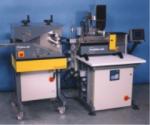Applications for extrusion are not confined to any single industry sector or scale of operation. They range from mega- to pilot-scale operations in industries as diverse as master-batch and compound manufacture in the polymer processing sectors, melt mixing of resins for powder coatings, continuous mixing in the food and pharmaceutical industries to fabrication, for example of rubber seals or plastic rods. To successfully carry out these operations efficiently, extruders must be capable of imposing a variety of conditions along the length of their barrel, depending on the application. Product specific requirements can include distinct heating and/or cooling zones, the facility to add metered quantities of extra ingredients (solid or liquid) at any point along the barrel, gas take-off or vacuum ports, and mixing, transport, hold-up etc zones as required. Extrudate may be in the form of pellets rods, sheet, film, etc and ancillary operations include premixing, blown films, cooling and pelletising.
Not only are the applications and requirements of extrusion diverse, so also are the physical quantities of product required. This depends on a number of factors, the foremost of which are the nature of the product, the nature of the business, and the differences in requirements between full production and product/process development or R&D.
High-end small- or pilot-scale equipment is invaluable for both small-scale production needs and for testing new ideas and the processability of, or conditions necessary for, new or improved production techniques. Current technology boasts small- and pilot-scale twin screw extruders (TSE’s) with segmented barrels and screws allowing flexibility through configuration changes in both. The scales of operation include 16mm, 24mm and 36mm TSE’s and the materials of construction are variable depending upon the application. Food and pharmaceutical applications often require specialised barrel and/or screw construction (from high grade stainless steel for example). These extruders may be bench-or skid mounted depending on their size, and screw L/D can range from as low as 14:1 to as high as 40:1, depending on user requirements.
For both R&D and production, it is important to measure and control process variables at the motor and along the shaft. Today’s technology allows precise control over motor torque and speed (and so power consumption and energy input), temperature profiles throughout the barrel, as well as the addition of extra ingredients or venting of waste gasses during the process. This is most often done through touch-screen controls, or by PLC control. In this way the effects of altering process conditions may be easily and cost effectively assessed, using small quantities of material, prior to larger-scale production.
For small-scale operations, the process may be precisely controlled and modified to take account of new conditions or changes in the quality or quantitye of the raw materials.
A copy of this application package note is available by quoting reference no: Rheo026

